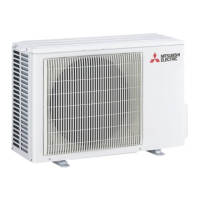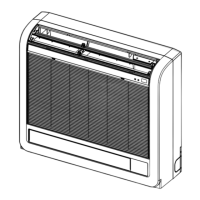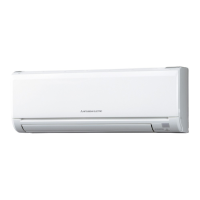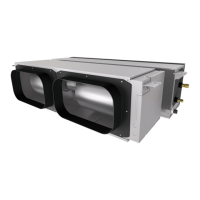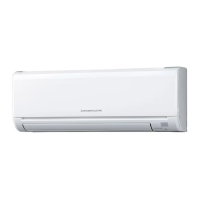-
98
-
④Installation of indoor unit (continued)
⑥Drain pipe
Caution
●
Install the drain pipe according to the installation manual in order to drain properly.
Imperfection in draining may cause flood indoors and wetting the household goods,etc.
●
Do not put the drain pipe directly into the ditch where toxic gas such as sulfur, the other harmful and
inflammable gas is generated. Toxic gas would flow into the room and it would cause serious damage to
user’s health and safety (some poisoning or deficiency of oxygen). In addition, it may cause corrosion of
heat exchanger and bad smell.
● Connect the pipe securely to avoid water leakage from the joint.
● Insulate the pipe properly to avoid condensation drop.
●
Check if the water can flow out properly from both the drain outlet on the indoor unit and the end of the
drain pipe after installation.
●
Make sure to make descending slope of greater than 1/100 and do not make up-down bend and/or trap
in the
midway. In addition, do not put air vent on the drain pipe. Check if water is drained out properly from the pipe
during commissioning. Also, keep sufficient space for inspection and maintenance.
Work procedure
4.
Prepare a joint for connecting VP25 pipe, adhere and connect the joint to the drain hose (the
rigid PVC side), and adhere and connect VP25 pipe (prepare on site).
※
As for drain pipe, apply VP25 made of rigid PVC which is on the market.
● Make sure that the adhesive will not get into the supplied drain hose.
It may cause the flexible part broken after the adhesive is dried up and gets rigid.
●
The flexible drain hose is intended to absorb a
small difference at installation of the unit or
drain pipes. Intentional bending, expanding
may cause the flexible hose
broken and water
leakage.
●As for drain pipe, apply VP25 (OD32).
If apply PVC25 (OD25), connect the expanded connector to the drain hose, with adhesive.
(Multi unit only)
5.
Make sure to make descending slope of greater than 1/100 and do not make up-down bend
and/or trap in the midway.
●
Pay attention not to give stress on the pipe on the indoor unit side, and support and fix the pipe
as close place to the unit as possible when connecting the drain pipe.
●Do nt set up air vent.
6. Insulate the drain pipe.
●
Be sure to insulate the drain socket and rigid PVC pipe installed indoors otherwise it may cause
dew condensation and water leakage.
※
After drainage test implementation, cover the drain socket part with pipe cover (small size), then use
the pipe cover (big size) to cover the pipe cover (small size), clamps and part of the drain hose, and fix
and wrap it with tapes to wrap and make joint part gapless.
●
When sharing a drain pipe for more than 1
unit, lay the main pipe 100mm below the
drain outlet of the unit. In addition, select
VP30 or bigger size for main drain pipe.
VP30 or bigger
Descending slope greater than 1/100
As wide as possible
(about100mm)
1.
Make sure that the drain hose (the soft PVC side) is inserted into the end of the step part of the
drain socket.
Fix the hose clamp so that its bolt is located on the outside of the indoor unit, and the bolt are
fastened in a vertical orientation.
●
Do not apply adhesives on this end.
2.
Position the hose clamp so that it touches the insulation of the drain hose, and then tighten the bolt
.
3.
Turn the bolt several times until it is securely tightened, but do not tighten it excessively.
Supporting metal
No bump
No trap
Not touching the water
Trapped air will
generate noises.
Air vent
Insulation material
1.5m – 2m
Descending slope greater than 1/100
⑤Refrigerant pipe (continued)
⑤Refrigerant pipe
●
Be sure to use new pipes for the refrigerant pipes. Use the flare nut attached to the product.
Regarding whether existing pipes can be reused or not, and the washing method, refer to the instruction manual of the outdoor
unit, catalogue or technical data.
1) In case of reuse: Do not use old flare nut, but use the nut attached to the unit.
2) In case of reuse: Flare the end of pipe replaced partially for R32 or R410A.
: When flared joints are reused indoors, the flare part shall be re-fabricated. (only for R32)
●
Use phosphorus deoxidized copper alloy seamless pipe (C1220T) for refrigeration pipe installation.
In addition, make sure there is no damage both inside and outside of the pipe, and no harmful
substances such as sulfur, oxide, dust or a contaminant stuck on the pipes.
●
Do not use any refrigerant other than the designated refrigerant.
Using other refrigerant except the designated refrigerant, may degrade inside refrigeration oil. And air
getting into refrigeration circuit may cause over-pressure and resultant it may result in bursting, etc.
●
Store the copper pipes indoors and seal the both end of them until they are brazed in order to avoid any
dust, dirt or water getting into pipe. Otherwise it will cause degradation of refrigeration oil and
compressor breakdown, etc.
●Use special tools for R32 or R410A refrigerant.
Caution
D
d
mm
6.35
9.52
12.7
15.88
19.05
For R32
For R410A
Conventional tool
Pipe diameter
Min. pipe
wall thickness
Protruding dimension for flare, mm
Rigid (Clutch type)
Flare O.D.
Flare nut
tightening torque
0 - 0.5 0.7 - 1.3
D
mm
8.9 - 9.1
12.8
-
13.2
16.2
-
16.6
19.3
-
19.7
23.6
-
24.0
N·m
14 - 18
34 - 42
49 - 61
68 - 82
100 - 120
mm
0.8
0.8
0.8
1
1.2
Protruding
dimension
Flare die
Drain hose
850mm or less
Joint for VP25
(Prepare on site)
⑥Drain pipe (continued)
●In case electrical wiring work completed
Drain pump can be operated by the wired remote control.
For the operation method, refer to Operation for drain pump in the installation manual for wiring work.
●In case electrical wiring work not completed
Drain pump will run continuously when the dip switch“SW7-1” on the indoor unit PCB is turned ON, the Connector
CNB is disconnected, and then the power supply (230VAC on the terminal block ① and ②) is turned ON.
Make sure to turn OFF “SW7-1” and reconnect the Connector CNB after the test.
●
After installing the drain pipe, make sure that drain system works correctly and that no water leaks
from the joint and drain pan. Check whether the motor sound of the drain pump is normal.
● Conduct a drain test when installing, even during the heating season.
● In the case of new buildings, be sure to complete the test before fixing the ceiling.
●
In case of pouring water from the air outlet
●
In case of pouring water from the pouring port of the pipe lid
1.
Pour about 1,000 cc of test water into the drain pan of the indoor unit. Exercise care not to
allow electrical equipment such as the drain pump and other components to become wet
while filling water.
Pour test water through the pouring port of the pipe lid using a feed water pump or a similar
device, or through the refrigerant pipe joint.
2. Make sure that water drains out completely and that no water leaks from any joints of the
drain pipe during the test.
Test to confirm that the water drains out correctly while listening to the drain pump motor operating sound.
At the drain socket (transparent), it is possible to check whether the water drains out correctly
.
3.
Unplug the rubber plug on the indoor unit so that the remaining water drains from the drain
pan after the draining test.
After checking the water drainage, fix the rubber plug correctly. Installation work for the drain
pipe must be performed for the entire drain pipe up to the indoor unit.
If the pipe lid has been removed in order to pour water, mount the pipe lid again.
215 to 245mm 100 or less
●
The position for drain pipe outlet can be raised up to
850mm above the ceiling. Use elbows for installa-
tion to avoid obstacles inside ceiling. If the horizon-
tal drain pipe is too long before vertical pipe, the
backflow of water will increase when the unit is
stopped, and it may cause overflow of water from
the drain pan on the indoor unit. In order to avoid
overflow, keep the horizontal pipe length and offset
of the pipe within the limit shown in the figure
below.
Drain test
Drain pump operation
Drain up
1. Remove the flare nut and blind flanges on the pipe of the indoor unit.
※
Make sure to loosen the flare nut with holding the nut on pipe side with a spanner and giving torque to the
nut with another spanner in order to avoid unexpected stress to the copper pipe, and then remove them.
(Gas may come out at this time, but it is not abnormal.)
● Pay attention whether the flare nut pops out. (as the indoor unit is sometimes pressured.)
2.
Make a flare on liquid pipe and gas pipe, and connect the refrigeration pipes on the indoor unit.
※Bend radius of pipe must be 4D or larger. Once a pipe is bent, do not readjust the bending.
Do not twist a pipe or collapse to 2/3D or smaller.
● Make sure to use flare nuts assembled on the unions.
Usage of other flare nuts could cause refrigerant
leakage.
※Do a flare connection as follows:
●Make sure to hold the nut on indoor unit pipe side
using double spanner method as indicated when
fastening / loosening flare nuts in order to prevent
unintentional twisting of the copper pipe.
● When fastening the flare nut, align the refrigeration
pipe with the center of flare nut, screw the
nut for 3-4
times by hand and then tighten it by spanner with the
specified torque mentioned in the table above.
3. Cover the flare connection part of the indoor unit with attached insulation material after a gas
leakage inspection, and tighten both ends with attached straps.
● Make sure to insulate both gas pipes and liquid pipes completely.
※ Incomplete insulation may cause dew condensation or water dropping.
● Use heat-resistant (120 °C or more) insulations on the gas side pipes.
● In case of using at high humidity condition, reinforce insulation of refrigerant pipes.
Surface of insulation may cause dew condition or water dropping, if insulations are not
reinfoced.
4. Refrigerant is charged in the outdoor unit.
As for the additional refrigerant charge for the indoor unit and piping, refer to the installation
manual attached to the outdoor unit.
<
The case of using thicness of insulation is 10mm
> <
The case of using reinfoced insulation
>
Pipe cover (Accessory)
Unit
Unit
Band (Accessory)
Band (Prepare on site)
Insulation (Prepare on site)
Pipe cover (Prepare on site)
Band (Accessory)
The thckness of insulation is 10mm
Work procedure
Refrigerating machine oil should not be applied to the threads of union or external surface of flare. It
is because, even if the same tightening torque is applied, the oil is likely to decrease the slide friction
force on the threads and increase, in turn, the axial component force so that it could crack the flare
by the stress corrosion.
Refrigerating machine oil may be applied to the internal surface of flare only.
Caution:
⑦Wiring-out position and wiring connection (continued)
Single Split (PAC) series
VRF (KX) series
●
Electrical installation work must be performed according to the installation manual by an
electrical installation service provider qualified by a power provider of the country, and be
executed according to the technical standards and other regulations applicable to electrical
installation in the country.
Be sure to use an exclusive circuit.
●
Use specified cord, fasten the wiring to the terminal securely, and hold the cord securely in order
not to apply unexpected stress on the terminal.
●
Do not put both power source line and signal line on the same route. It may cause miscommuni-
cation and malfunction.
●
Be sure to do D type earth work.
●
For the details of electrical wiring work, see attached instruction manual for electrical wiring work.
1.
Loosen the 2 screws of the lid of the control box, and slide the lid in the direction of the arrow
shown in the figure. It will then be possible to open the lid.
2.
Unhook the lid from the control box,
and remove the lid.
3.
Remove the 2 screws from the wiring
cover, and remove the wiring cover
.
4.
Hold each wire inside the unit, and securely
fasten them to the terminal block
.
5.
Fix the wiring using clamps.
6.
Install the wiring cover and the lid of
the control box
.
Main fuse specification
Specification
T3.15A L250V
Part No.
SSA564A149AF
⑧Panel installation
●Install the panel on the indoor unit after electrical wiring work.
●Refer to the attached manual for panel installation for details.
⑩
How to check the dirt of drain pan and cleanimg the inlet of the drain pump. (Maintenance)
The method of checking the dirt of drain pan
●
It is possible to check dirt on the drain pan and drain pump inlet without removing the panel.
1. Open the inlet grille and remove the corner lid on the drain pan side.
2. Remove the drain cap cover (1 screw) from the panel corner.
3. Check the dirt on the dra
in pan from the drain cap, and check the drain pump inlet. If the
drain pan is very dirt
y, remove the drain pan and clean it.
4.
After checking, refix the drain cap cover securely.
If the cover is not refixed correctly, it may cause condensation to form and/or water to leak
.
⑨Check list after installation
215ー245mm
PVC25 (Prepare on site)
Elbow (Accessory)
(Multi only)
Drain hoseIndoor side
Protection of the indoor unit
● If it is not possible to install the panel for a while or if attaching the ceiling board after
installing the indoor unit, protect the indoor unit by using upper carton.
Caution
● Do not adjust the unit height by adjusting the upper nuts. Doing so will cause unexpected
stress on the indoor unit and cause the unit to become deformed, prevent the panel from
being installed, and be generated fan interference noise.
● Make sure that the indoor unit is installed horizontally and set the appropriate gap between
the underside of the unit and the ceiling plane. Improper installation may cause air leakage,
dew condensation, water leakage and noise.
● Even after the panel has been installed, the unit height can still be finely adjusted. Refer to
the panel installation manual for details.
● Make sure there is no gap between the panel and the ceiling surface, and between the
panel and the indoor unit. Any gap may cause air and/or water to leak, or condensation to
form.
The step part
Drain hose
Drain socket
17–20 mm
(1.2–1.5N·m)
Target extent of bolt
tightening should be 17
to 20 mm (Reference:
1.2 to 1.5N-m).
Drain socket
Hose clamp
Drain hose
Position the hose clamp so that it touches the insulation of
the drain hose, and securely tighten the bolt.
Do not connect the parts using adhesives.
Joint for VP25
(Prepare on site)
Joint for VP25
(Prepare on site)
Joint for VP25
(Prepare on site)
Drain socket
Drain hose
(Accessory)
Pipe cover (small)
(For insulation)
(Accessory)
Unit
Pipe cover
(For insulation)
(Prepare on site)
Hose clamp
(Accessory, no adhesive allowed.)
Pipe cover (big)[For
insulation] (Accessory)
20mm or more
Pipe lid
Pouring port
Grommet
⑦Wiring-out position and wiring connection
Hook the
claws to the
control box.
Slide the lid
and hook the
hole onto the
screw head
.
Screws
Wiring cover
Hook of the lid
Screws
Loosen the 2
screws, and
slide the lid to
open it.
Hook of the lid
Lid of the
control box
When opening the lid of the control box When closing the lid of the control box
Main fuse
Earth
Power source
side terminal
block
Signal side
terminal block
Band
Wiring between indoor
and outdoor units
Remote
control line
Power source
side terminal
block
Signal side
terminal block
Earth
Band
Main fuse
Indoor power
source line
Remote
control line
Super link line
Corner
lid
Drain
cap
cover
Drain
cap
Drain
pump
inlet
Cleaning of drain pump inlet
●
It is possible to clean the drain pump inlet and surrounding area by removing the drain cap only; it
is not necessary to remove the panel and drain pan.
●
Before removing the drain cap, remove the rubber plug and drain water from the drain pan.
1.
Remove the drain cap cover as described above.
2.
Insert the nose of the pliers into the concave portions (2 places) of the drain cap, and rotate the pliers
about 1 turn in the CCW direction. The drain cap is removed.
3. When cleaning the drain pump inlet, use a soft plastic tool. If a metallic tool is used, the
drain cap mounting portion may be scratched and water may leak.
4.
Before mounting the drain cap, rinse it and remove any foreign material from the inside of the
cap. If the drain cap is installed with foreign material inside it, it may cause water to leak
.
5.
Insert the nose of the pliers into the concave portions of the drain cap and rotate the pliers to install the
drain cap. Rotate the drain cap about 1 turn in the CW direction until it stops rotating. If the drain cap is
not rotated for 1 or more turns, the cap will not have been installed correctly
.
Remove the drain cap, and then install it again correctly.
6.
After tightening the drain cap, make sure the triangle () mark of the drain cap comes close to the triangle mark
on the panel. If these triangle marks are not close to each other, tighten the drain cap further
.
7.
Refix the drain cap cover and rubber plug securely. If the cover is not refixed correctly, it
may cause condensation to form and/or water to leak.
Notes for removing the drain pan
●
Before removing the drain pan, drain water from the drain pan. Remove the rubber plug and drain water
.
●
The drain pan is installed by the temporary installation plate. Remove the 2 drain pan fixing screws, and
loosen the 2 screws of the temporary installation plate.
Slide the temporary installation plate to the outside of the drain pan. And then,it is possible to remove the drain pan
.
●
When reinstalling the drain pan, slide the temporary installation plate to the inside and temporarily fix the drain pan. Then, tighten the 2
drain pan fixing screws and the 2 screws of the temporary installation plate. Also, refix the rubber plug securely
.
●Check the following items after all installation work completed.
Check if; Expected trouble Check
The indoor and outdoor units are fixed securely?
Falling, vibration, noise
Inspection for leakage is done? Insufficient capacity
Insulation work is properly done? Water leakage
Water is drained properly? Water leakage
Supply voltage is same as mentioned in the model name plate?
PCB burnt out, not working at all
There is mis-wiring or mis-connection of piping?
PCB burnt out, not working at all
Earth wiring is connected properly?
Electric shock
Cable size comply with specified size?
PCB burnt out, not working at all
Any obstacle blocks airflow on air inlet and outlet? Insufficient capacity
Rubber plug
Drain cap cover
Insert the nose of the pliers into the concave
portions, and rotate the drain cap.
Drain cap
Exercise care not to scratch the end, inside, or
threads of the drain cap seal.
Drain pan
Drain pump
Drain pump inlet
Triangle () mark of
the drain cap
Triangle () mark of the panel
Tighten the drain cap so that the 2 triangle
marks come close to each other.
Reinforcing carton
of the inside upper
carton
Fix the upper carton by using
panel fixing bolts. The upper
carton has "+" shape slits at
the same position as the
panel fixing pitch.
Band
Band
Slide the plate
to the outside.
Loosen the
screws.
Remove the
screws.
Temporary
jinstallation
plate of the
drain pan
Torque
wrench
Union
Flare nut
Spanner
Indoor unit
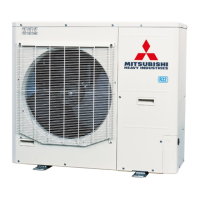
